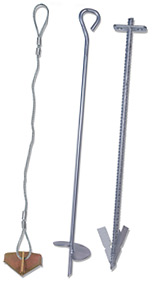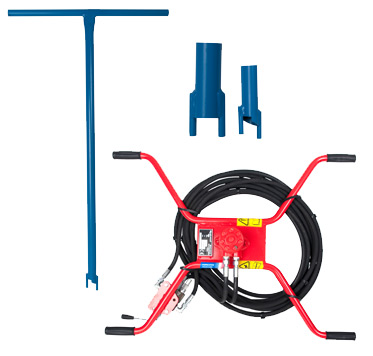Anchor information, everything you need to know...
 What is an anchor?
What is an anchor?
A mechanical product designed to resist pulling forces in the ground and offer a permanent or temporary fixed point.
What can be anchored in the ground without using concrete?
- A row of vines.
- A row of apple trees or kiwi trees.
- A tree.
- Tree roots.
- A structure supporting an anti-hail net, an anti-bird net, a windbreaker or a shade.
- A greenhouse.
- A tent.
- A signpost, an electrical pole.
- A pontoon.
- A tank.
- A boat.
- A marker buoy.
- A pipeline, a telecommunications cable,
- etc.
| Characteristics | Properties |
|---|---|
| Resistance capacity (depending on anchor type) | 250 to 12,000 kg |
| Anchor depth (depending on soil type) | 500 to 2,500 mm |
Definition of anchoring
The anchor is chosen based on 2 main specifications:
The force supported by the anchor
This force is defined by:
- the grape variety and its leaf density, which identify the Trellis Height
- the type and size of the End Post
- the type and size of the End Post
- The pull forces of the supporting and elevating wires
- The Wind Exposure Conditions
The type of soil
Independently of their chemical nature, soils can be classified into 4 categories:
- light and soft soil
- lightly rocky and moderately consistent soil
- moderately rocky and dense soil
- very rocky and compact soil
Each type of soil has a different pull-out resistance, identified by its extraction cone.
Choosing an anchor
SCREW-IN ANCHORS
For soft to moderately dense soils with few rocks:
the DISK diameter and the insertion depth determine the developed surface area of the extraction cone and therefore the SOIL’s RESISTANT STRENGTH.
The diameter and thickness of the DISK; the diameter, length and type of steel of the ROD as well as the type of wire or cable fastening loop determine the ANCHOR’s RESISTANCE to PULL-OUT FORCES and SCREW-IN TORQUE.
Hammer-in anchors
For compact soils with lots of rocks.
- SPEARS
the geometry of the BLADES and their position in the HOLDER after rotation, and the insertion depth determine the developed surface area of the extraction cone and therefore the SOIL’S RESISTANT STRENGTH.
the diameter, length and type of steel of the ROD as well as the type of
wire or
cable fastening determine the ANCHOR’S RESISTANCE to PULL-OUT and IMPACT FORCES. - TILTERS
the geometry and surface area of the PLATE and the insertion depth determine the developed surface area of the extraction cone and therefore the SOIL’S RESISTANT STRENGTH.
the diameter, length and type of steel of the LINK CABLE as well as the shape of the fastening loop determine the ANCHOR’S RESISTANCE to PULL-OUT and POSITIONING FORCES.
The Anchoring point
The ANCHORING POINT is the entire system which links the TRELLIS ROW to the ANCHOR by its END POST. This system includes:
- the ANCHOR
- the link CABLE or WIRE and its attachment system
- the TENSIONER
These 3 elements must be STANDARD. As an example:
- 1 x 3 mm diameter CABLE or WIRE, with a breakage resistance of: 90 daN/mm² can support a maximum force before breakage of: 635 daN
- 1 x 6 mm diameter ROD, with a breakage resistance of: 67 daN/mm² (ANCREST steel) can support a maximum force before breakage of 1893 daN.
The benefits
- Ancr’est is a benchmark in both the agricultural and industrial markets.
- It has 40 years of experience, with field tests and studies validated by professionals in each business sector.
- The materials used to make the anchors are selected for their significant mechanical resistance.
- The anchors are designed to resist corrosion.
- Respect for the environment when installed and used.
- As a European leader, Ancr’est anchors are distributed through our huge dealer network.
- Guaranteed service, both in the choice of products and follow-up.
Assets
- A reliable and safe product, recognised by professionals for 40 years.
- Easy and quick to use.
- Excellent value for money.
- Very little damage to soil.
- Time saved as it can be used immediately, without prior digging and no rubble created.





 Easy to use
Easy to use